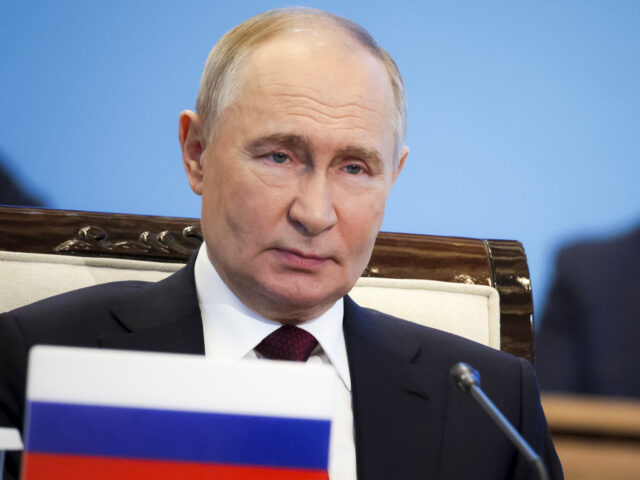Russian President Vladimir Putin has made a list of threats and boasts in a speech Thursday morning, saying strikes by Ukraine into Russia using Western missiles will “of course” be answered, with Ukrainian “decision-making centres in Kyiv” as a potential target.
The United States permitted Ukraine to strike into Russia using American-supplied weapons against Moscow’s warnings this would escalate the conflict and the warning of a single launch of an experimental new weapon by Russia has been ignored, President Vladimir Putin complained on Thursday morning.
Speaking at a meeting of Russia’s mini-NATO analogue in Kazakhstan, the Collective Security Treaty Organisation (CSTO), the Russian leader talked up the potency of the new ‘Oreshnik’ ballistic missile which caught attention worldwide last week when it was launched against Ukraine for the first time and said retaliatory strikes could aim to wipe out “decision-making centres in Kyiv”. These comments are the latest such threats of massive retaliation and escalation by the Kremlin, but Putin tempered his remarks by insisting while such strikes would leave Ukraine looking like it had been hit by a nuclear weapon, the missile would be loaded with conventional explosives in future.
Boasting of the power of the Oreshnik missile, which Western observers have suggested is a development growing out of an existing Russian ICBM, Putin made several claims of its alleged capabilities. Among them was its stated ability to strike “highly protected objects located at great depths”, that no other weapon in the world is quite like it, that when it plunges back to earth from space on its ballistic launch trajectory it reached 4,000 degrees Celsius (7,200 Fahrenheit), two thirds as hot as the surface of the sun.
While he said the missile is not “a weapon of mass destruction”, a cluster-attack of such weapons would be like a nuclear strike on a city, Putin claimed. He said: “a massive, group use of these missiles, that is, several missiles at once, in a cluster, in one strike, its power will be comparable to the use of nuclear weapons… dozens of warheads – homing units – attack the target at a speed of 10 Mach. This is about 3 km per second”. The explosive force, he claimed, is great enough to reduce the target into its constituent “elementary particles”: “It turns, essentially, into dust”.
A frightening prospect if taken at face value, but the Oreshnik is an experimental missile and there is no indication Russia has a large store of them. Indeed, as suggested by footage of the initial test of the weapon against the Ukrainian city of Dnipro last week and as later confirmed the first Oresknik missile carried no warhead whatsoever, nuclear or otherwise. The damage caused was apparently purely from the kinetic energy of the missile casings falling to earth at great speed.
Putin moved to claim he could field large numbers of missiles, however, boasting the Russian military-industrial complex is so great it can produce ten times more missiles a year “than the combined production of all NATO countries combined”. While this figure is almost certainly grossly inflated for rhetorical effect, it is certainly the case Western nations made the most of the ‘peace dividend’ of the end of the Cold War and allowed their military industrial capabilities to atrophy with money spent elsewhere. This became a factor that has been keenly felt in recent years with shell and missile shortages and serious barriers to ramping up production, and much NATO time is now focussed on how to re-establish production lines.
Among all the threatening statements, the Russian leader repeatedly said he blamed Western nations for supplying Ukraine with long-range missiles and permitting them to be used against the Russian interior. While this is no less than the missile attacks Russia has been launching against Ukraine for almost three years now, evidently the Kremlin considers Ukraine being equipped to do the same in return unfair or unacceptable.
Putin said the first ATACMS and Storm Shadow — American and British missiles respectively — came last week despite his “warnings” and continued in spite of the Oreshnik strike. He told his fellow CSTO leaders from Kazakhstan, Belarus, Kyrgyzstan and Tajikistan he was “forced” to respond, and said: “We have repeatedly drawn attention to the fact that this would mean the direct involvement of these countries in an armed conflict… Nevertheless, despite our warnings about the danger of escalation of the conflict, strikes on our territory were carried out”.
Russia would “of course” respond to continued ATACMS and Storm Shadow strikes on the Russian hinterland, he said, stating new military target lists were being drawn up which appear to include the Ukrainian government. Putin said: “Currently, the Ministry of Defence and the General Staff of the Russian Army are selecting targets to hit on Ukrainian territory. These could be military facilities, defence industry enterprises, or decision-making centres in Kyiv”.
The Ukrainian leadership were called illegitimate neo-Nazis in the speech, a common claim by the Kremlin that harks back to the respective positions of Russia and pro-German Ukrainian fighters during the Second World War.
On Thursday morning, Ukraine said they had been the subject of a large-scale Russian attack overnight, with Kyiv state media saying there had been strikes against Kyiv, Vinnytsia, Odesa, Volyn, Kharkiv, Ivano-Frankivsk, Chernivtsi, and Sumy. Ukraine’s Air Force said it had intercepted dozens of missiles and drones.
In particular, Ukraine claims Russia used “cluster munitions” to strike the nation’s power grid overnight, which President Zelensky decried as a “despicable escalation” and a terrorist attack.

COMMENTS
Please let us know if you're having issues with commenting.